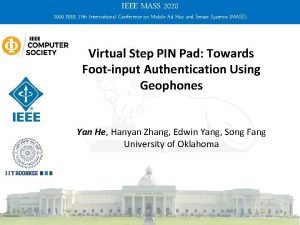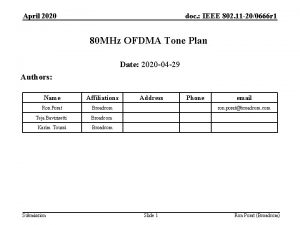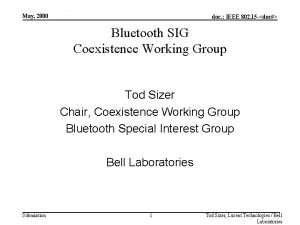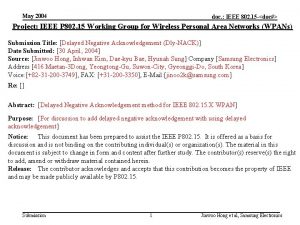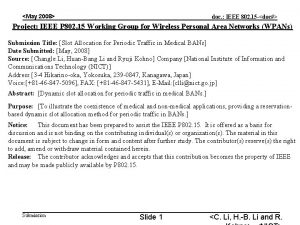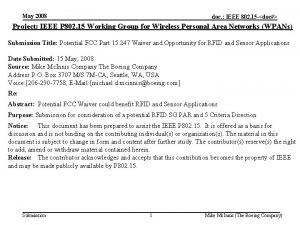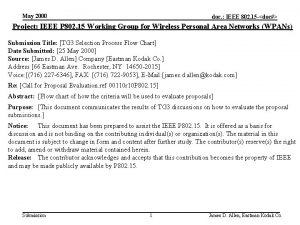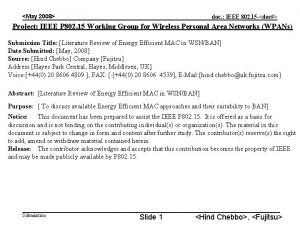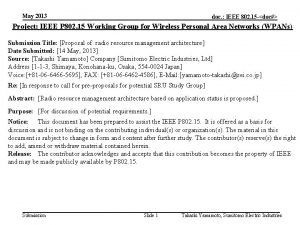May 2020 doc IEEE 802 11 200666 r









![May 2020 doc. : IEEE 802. 11 -20/0666 r 2 References • [1] 19/1340 May 2020 doc. : IEEE 802. 11 -20/0666 r 2 References • [1] 19/1340](https://slidetodoc.com/presentation_image_h/1ab1db4a1144dd62bbaed6242f0114d2/image-10.jpg)


- Slides: 12

May 2020 doc. : IEEE 802. 11 -20/0666 r 2 80 MHz OFDMA Tone Plan Date: 2020 -05 -01 Authors: Name Affiliations Address Phone email Ron Porat Broadcom ron. porat@broadcom. com Teja Bavirisetti Broadcom Karim Toussi Broadcom Wook Bong Lee Samsung Submission Slide 1 Ron Porat (Broadcom)

May 2020 doc. : IEEE 802. 11 -20/0666 r 2 Abstract • The problems of the 11 ax OFDMA 80 MHz tone plan are well known and presented previously in [1] – inner 242 RU tones (and smaller RU at the edge) fall inside the adjacent 20 MHz boundary • We propose a very simple modification to the tone plan to solve the issues without the need for any re-design of current RUs (as suggested in [1]) Submission Slide 2 Ron Porat (Broadcom)

May 2020 doc. : IEEE 802. 11 -20/0666 r 2 Re-cap of Issues • Meeting spectral masks for punctured 20 MHz. In particular we have investigated the requirements for meeting the new ETSI spectral masks that apply to both DL and UL • Meeting spectral masks in UL OFDMA - this was not even considered in 11 ax • 20 -only or 20 -operating devices decoding small RUs at the edge of the inner 20 MHz or an inner 242 RU • Requirement for ED in two 20 MHz for TB PPDU RU that fall on the edge of an inner 20 MHz. This is different from the behavior in DL-OFDMA would like UL OFDMA ED to be similar to DL OFDMA which requires ED only in the utilized 20 MHz subband Submission Slide 3 Ron Porat (Broadcom)

May 2020 doc. : IEEE 802. 11 -20/0666 r 2 Cont. • Center 26 RU in 80 MHz - – We find that we don’t use it in DL OFDMA, easier for the scheduler to consider RUs in the four 20 MHz subbands – It also requires checking ED in both 20 MHz bands in TB PPDU which is highly inconvenient. – In addition in 11 ax we already puncture it out any time we puncture the inner 20 MHz which means the OFDMA design changes between puncturing and not puncturing which is undesirable • Prefer one unified 80 MHz OFDMA plan for all cases Submission Slide 4 Ron Porat (Broadcom)

May 2020 doc. : IEEE 802. 11 -20/0666 r 2 An Example Simulation Result • ETSI masks require meeting a -20 d. Br point at 1 MHz away from the 20 MHz channel boundary. ETSI uses 1 MHz RBW which makes it more difficult to meet than IEEE requirement that uses 100 KHz RBW. – For first 1 MHz region can use 99% OBW criterion but -20 d. Br point is the bottleneck • Typical filters used in spectrum analyzers will capture the desired signal energy (1 MHz is only the -3 d. B BW) and will require puncturing of the signal to meet -20 d. Br point. • We have done many simulations with various configurations, channels and rates and provide here an example for the performance of an inner 242 RU with the required puncturing needed to meet the spectral mask in the adjacent outer punctured 20 MHz channel Submission Slide 5 Ron Porat (Broadcom)

May 2020 doc. : IEEE 802. 11 -20/0666 r 2 Cont. • In this particular example the loss is too high for the 242 RU to be used in this configuration. Submission Slide 6 Ron Porat (Broadcom)

May 2020 doc. : IEEE 802. 11 -20/0666 r 2 Proposal for 80 MHz OFDMA Tone Plan • Make 80 MHz OFDMA tone plan an exact duplicate of the 40 MHz OFDMA plan by shifting the 40 MHz plan by +/-20 MHz to be centered around each 40 MHz – This is in the same spirit of making 160, 240 and 320 MHz exact duplicate of the 80 MHz tone plan 12 1 26 26 26 Edge 12 1 52 2 52 Edge 102+4 12 1 Edge 1 26 26 26 1 52 2 52 1 26 1 12 Edge 242 12 Edge 484 L 12 Edge 102+4 5 1 D 1 C 1 5 D C 1 26 26 26 52 2 52 1 26 1 52 2 52 102+4 1 26 1 242 484 R 102+4 2 2 2 2 1 1 26 2 12 1 11 6 6 6 6 Edge 1 11 12 1 52 2 52 1 26 1 52 2 52 Edge 2 1 11 102+4 1 1 12 1 6 Edge 11 242 12 Edge 11 12 484 L Edge 1 1 5 1 D C 1 1 2 26 6 52 2 2 6 6 52 102+4 2 6 1 26 1 1 2 6 1 1 1 2 26 6 52 2 2 1 11 6 6 Edge 2 52 1 11 Edge 102+4 1 11 Edge 2 5 D C 242 11 Edge 5 D C 484 R 11 Edge 996 usable tones +5 DC • • • Reminder: 40 MHz tone plan location [-244: -3 3: 244] Proposed 80 MHz OFDMA plan: {-256+ [-244: -3 3: 244] , 256+ [-244: -3 3: 244] } = [-500: -259, -253: -12, 12: 253, 259: 500] – Essentially only the red portions and the smaller RU under are shifted relative to 11 ax – The 484 RU is similarly changed to have 5 empty tones in the middle – 80 MHz OFDMA = 40 MHz DUP Table 27 -8 in 11 ax D 6 right/left shifted by 256 tones Submission Slide 7 Ron Porat (Broadcom)

May 2020 doc. : IEEE 802. 11 -20/0666 r 2 Cont. – See Appendix for the construction of that table • Notes: – The 80 MHz OFDMA design applies to any RU<996 for all modes of transmission, SU, DL MU, TB PPDU, with and without puncturing – Non-OFDMA full BW 80 MHz segment uses 996 RU design – Any punctured 80 MHz segment uses the OFDMA tone plan – For each 80 MHz segment in 160 MHz, 240 MHz or 320 MHz: if it’s punctured or used for OFDMA the 80 MHz OFDMA tone plan is used, if it’s used for non. OFDMA and non-punctured the 996 RU tone plan is used Submission Slide 8 Ron Porat (Broadcom)

May 2020 doc. : IEEE 802. 11 -20/0666 r 2 Summary • Proposed an 80 MHz OFDMA tone plan to solve the issues of the 11 ax 80 MHz tone plan without requiring new RU design • The new tone plan requires very minor modification to the 11 ax tone plan and ensures better performance and consistency in puncturing and non-puncturing cases. Submission Slide 9 Ron Porat (Broadcom)
![May 2020 doc IEEE 802 11 200666 r 2 References 1 191340 May 2020 doc. : IEEE 802. 11 -20/0666 r 2 References • [1] 19/1340](https://slidetodoc.com/presentation_image_h/1ab1db4a1144dd62bbaed6242f0114d2/image-10.jpg)
May 2020 doc. : IEEE 802. 11 -20/0666 r 2 References • [1] 19/1340 r 3 Revisiting the 20/40/80 MHz Tone Plan Submission Slide 10 Ron Porat (Broadcom)

May 2020 doc. : IEEE 802. 11 -20/0666 r 2 Appendix - New Table 27 -9 Data and pilot subcarrier indices for RUs in an 80 MHz EHT PPDU and in a non-OFDMA 80 MHz EHT PPDU Submission Slide 11 Ron Porat (Broadcom)

May 2020 doc. : IEEE 802. 11 -20/0666 r 2 Straw Poll 1 • Do you support the following tone plan for 11 be 80 MHz OFDMA? • 80 MHz OFDMA = 40 MHz DUP , Table 27 -8 in 11 ax D 6 right/left shifted by 256 tones 12 1 26 26 26 Edge 12 1 52 2 52 Edge 102+4 12 1 Edge 1 26 26 26 1 52 2 52 1 26 1 12 Edge 242 12 Edge 484 L 12 Edge • 102+4 5 1 D C 1 5 1 D 1 C 1 5 D C 1 26 26 26 52 2 52 1 26 1 102+4 242 484 R 102+4 2 2 2 2 1 1 26 2 12 1 11 6 6 6 6 Edge 1 11 12 1 52 2 52 1 26 1 52 2 52 Edge 2 1 11 102+4 1 1 12 1 6 Edge 11 242 12 Edge 11 12 484 L Edge 1 1 5 1 D C 1 1 2 26 6 52 2 2 6 6 52 102+4 2 6 1 26 1 1 2 6 1 1 1 2 26 6 52 2 2 1 11 6 6 Edge 2 52 1 11 Edge 102+4 1 11 Edge 2 5 D C 242 11 Edge 5 D C 484 R 11 Edge 996 usable tones +5 DC Notes: – The 80 MHz OFDMA design applies to any RU<996 for all modes of transmission, SU, DL MU, TB PPDU, with and without puncturing – Non-OFDMA full BW 80 MHz segment uses 996 RU design – Any punctured 80 MHz segment uses the OFDMA tone plan – For each 80 MHz segment in 160 MHz, 240 MHz or 320 MHz: if it’s punctured or used for OFDMA the 80 MHz OFDMA tone plan is used, if it’s used for non-OFDMA and non-punctured the 996 RU tone plan is used Submission Slide 12 Ron Porat (Broadcom)











